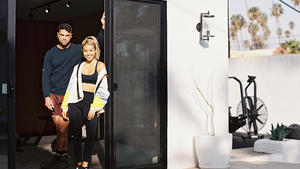Once you’re in the door, there’s plenty of advice floating around about style, project management, budget and all the rest—but how do you actually get the job in the first place? We’re asking designers to peel back the curtain and walk us through how they landed a project, step by step. This week, Bridgehampton, New York–based architect Blaze Makoid shares how a series of phone calls lead to a dreamy project: an 8,650-square-foot vacation home in Jackson Hole, Wyoming.

Tell me the backstory on this project.
A few years ago, I got a call from a guy in San Francisco who said he saw a ski house that we recently completed at Lake Tahoe, loved it and was searching for the right location to build a vacation home for his family. We spent many of my evenings over the next few months talking on the phone. Each conversation was a relaxed, back-and-forth exchange of questions, answers, ideas about how he wanted to live and how the right design could support those goals—not to mention a fair amount of conversation that had nothing to do with the project.
At some point during our calls, my wife started to wonder what was going on. Why was I talking to this guy all the time? “He’s in California and you’re in New York … and the project’s in Wyoming.” I imagined his wife was [asking similar] questions. Finally, I got the call [with the news] that he found the spot: in Jackson Hole, with a phenomenal view of the mountain.
Only 2,000 miles away, then—no big deal. How did you actually meet?
My future client mentioned that he’d be in New York City on business in a few weeks and wanted to see my office, which is in Bridgehampton. The plan was for him to take the Jitney [bus] out; I’d pick him up, show him my office and then we’d go for dinner. Keep in mind, at this point we had never met. I arrived at the bus stop and he stepped off … wearing the exact same clothes I was wearing! We had a great office visit and then headed to dinner, where the waitress took our drink order—the exact same order. This was repeated with the entrée as well. It was the start of a beautiful relationship!
Years later, after the project was complete, he admitted that on the bus ride out to Bridgehampton, he was texting his wife back in San Francisco asking, “Why am I on a BUS, going out to the HAMPTONS, for a project in WYOMING, when we live in CALIFORNIA?!” I still owe a debt of gratitude to his wife for helping him to hang in there.
I love that. How did you do such a good job connecting over the phone? I think that’s something a lot of people struggle with, especially when discussing visual ideas.
It worked because he had a lot of questions. So it wasn’t me trying to push something, it was me answering things: “What did you do here? How does this work?” It was me responding, as opposed to trying to sell something.
Sometimes, certain people you just hit it off with. He’s really easy to talk to, and I guess he found me pretty easy to talk to, and our conversations were very casual and relaxed. I felt like I was talking to somebody I knew, versus a client. It helped that he’d seen one of our projects in real life. It’s not like when I started the business, when you’d have an interview and you weren’t really sure if they knew what kind of work you did or didn’t do. We only do modern architecture, and we’re not capable of doing anything else.

In general, how do you pitch clients?
We’ve had great success when we’ve said, “Can you [share] a day in your life with us? From when you wake up to when you go to bed, what’s that day like?” And when we get that information, that’s a great way for us to shape the conversation.
What do you wear to initial meetings?
I think about that all the time, because I’m really jealous of technical clothing—these pants that you can run in and can go to the office in. But right now in New York, it’s 35 degrees and raining, and it’ll probably snow tonight. And summer in the city can be 95 degrees in broad daylight and humid. So typically, I don’t wear a tie—I only wear a tie to go to a wedding. I’ll wear a collared shirt and jeans.
What do you bring with you?
Typically, I just go with my iPad. In all honesty, most of those meetings, I don’t even open it up—we just talk. More often than not, I’m meeting them on their turf, at a conference room in somebody’s office. What I try to get across is that we’re going to get a great house at the end, and we’re trying to have a great experience along the way.
There will be a problem at some point in the process. It’s inevitable. It may be small or large, but you want to pick the person or firm or [so that] you feel comfortable that when something does go sideways, there’s going to be the person helping fix it and make it right—not trying to blame someone else, or [ignoring] it or losing their temper. You need to have a natural comfort level and feel like you’ve got the right team.
How much research do you do online before your first meeting?
You know, it’s funny. I keep forgetting to Google the person before I meet them. I know my office manager does, because she’s just curious. But I rarely do unless I’ve been talking to them for a while already.
But I feel like that information can set you up with false expectations. You may read something that’s negative or seems positive about that person, and you’re going to predetermine that “this is going to be a struggle” or ... “this guy’s going to be great” or whatever it might be. And then you have to unwind those preconceptions, which can be troublesome.
Do you ever leave a meeting and just say, ‘I don’t want to work with this person’? How do you handle that?
It’s hard to say. I don’t gamble and I don’t play poker, because I don’t think I have a good poker face. So I try to be as nice as possible, but sometimes I know as I’m walking out the door, “This would just be bad.” But I always follow up.
How do you decline? Are you honest, or do you just say, ‘I’m really busy right now’?
I don’t say I’m busy, because I feel that can be deceitful in a way. I mean, if you’re going to meet somebody, you’re probably going because you aren’t too busy to take the job. I just email them and say, “I just don’t think we’re the right fit for this project.” You don’t really have to get very detailed. Most of our clients are super busy and they’re businesspeople and they get it.

Tell me how you approach pricing, and how you explain it to clients.
It’s the hardest thing to do, because you never really know where you’re at in the conversation. We talk about how we structure our fee, and we try very hard to be consistent with that, no matter who we’re meeting with, partly because many of our clients know many of our other clients.
Usually, talking about it is a part of the first face-to-face meeting. From there, we put together a two-page outline proposal. It hits the bullet points that everybody’s interested in: What’s the rough cost of the project that everybody’s agreeing to, how big is the project and what’s the schedule. There’s no legalese—it’s just hitting those topics. And assuming that the client agrees to those bullet points, we then put together an AIA (American Institute of Architects) agreement—an industry standard contract. It’s much more in-depth, and it takes time to do.
I learned my lesson years ago; we would spend a lot of time putting a proposal together, and then not get the job. The outline proposal helps in that it doesn’t take a lot of time. We can typically put one together in a couple hours—and there’s no harm, no foul.
Is the AIA agreement a PDF you send over email?
Yeah. One of the nice things about it is it shows all the edits to the bullet points. So the client can challenge our position or reasoning and say, “Well, why did you change this?” It’s right there. It’s super transparent. And I think it helps put together the level of trust. So it’s not this opaque document that they have to start from scratch on.
For the majority of our work, we base our fee on costs—the percentage of the cost of construction. We bill monthly against that agreed amount. And then we fix our fee at the end, after a detailed cost at the end of schematic design. And that will keep us within shooting range of what we feel like we should earn. It gives the client a comfort level that we’re not suggesting things to just bump our fee up. But at the same time, they know it’s impossible to agree to a fee at the beginning, before you put pencil to paper—because this could go anywhere.
Homepage image: Paul Dyer Photography




























